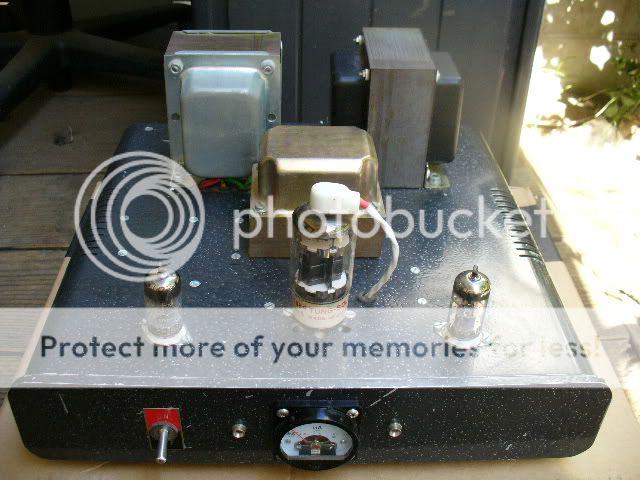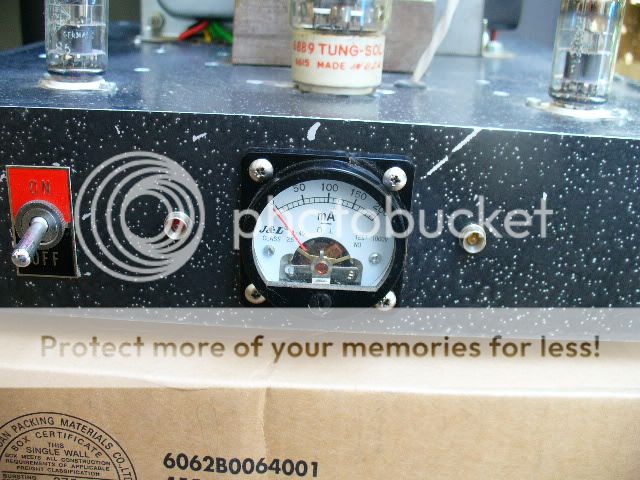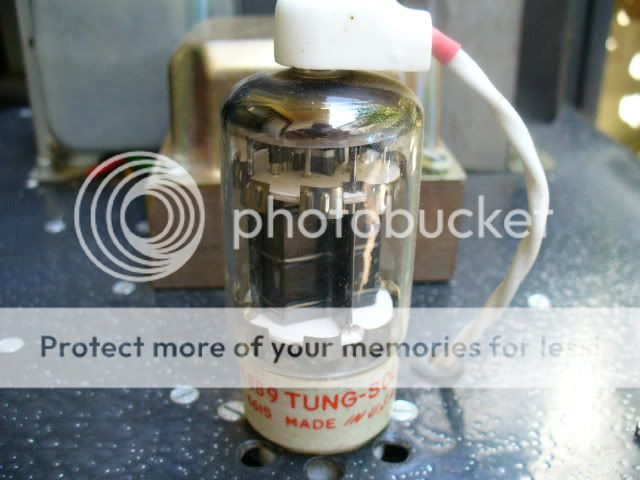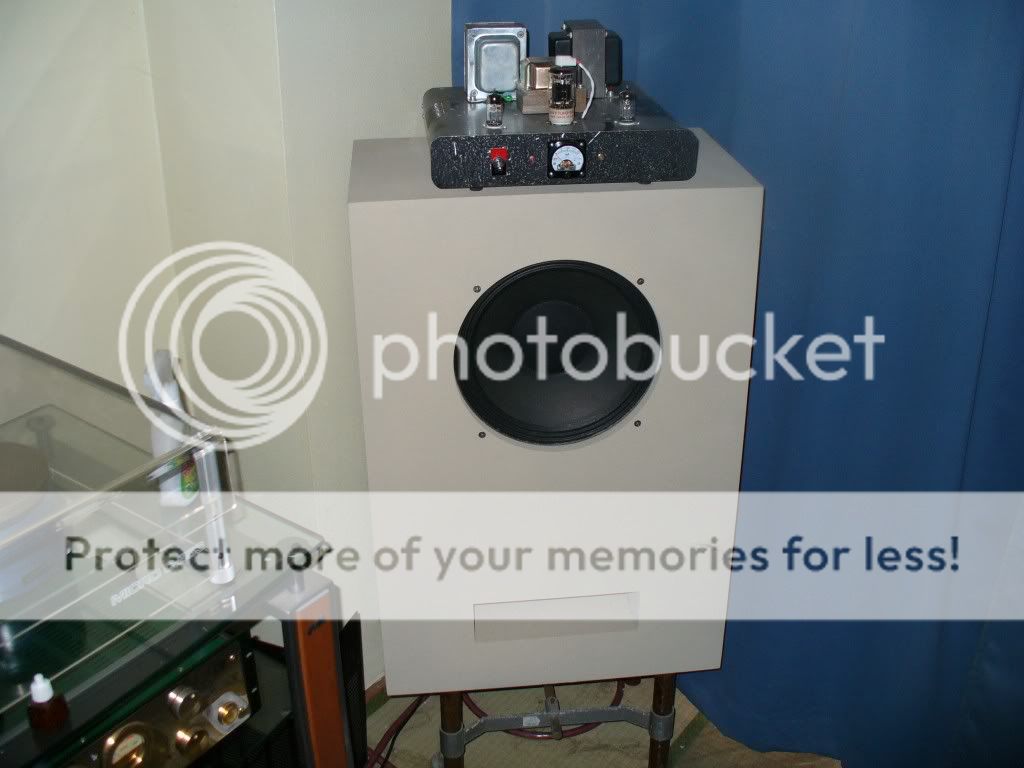The last couple of weeks I have been tinkering with 6889's in my Simple SE. A scouring of my stash turned up two sets - a pair that are Bendix branded and marked with the HYG 300 trade dress, and another pair that were probably unused pulls from something that are completely unmarked, no type number, no nomenclature whatsoever, but are clearly 6889 and from the ceramic look to be Bendix made, rather than Tung Sol or Cetron.
I saw some posts on here of a fellow who commissioned construction of a 6889 amp, but there was no follow up information with regard to operating points, etc. Since there seems to be little useful information in the HiFi sites regarding these tubes, here are some of my observations thus far, strictly for what they are worth.
The first general consensus in the HiFi world is that 6889 is just a 6384/6AR6 with a plate cap. I haven't compared the curves, but 6384 has a 325 volt screen limitation - 6889 has a screen rated for 850 volts. That's a pretty big difference.
The second general consensus is that these tubes are to be run like 6L6, with a little different bias, even though Bendix describes both 6889 and 6384 types as high perveance in the first sentence of the respective data sheets. So, following the general consensus, I set my Simple SE up for the wimps of the 6L6 family - the plain jane 6L6 - and had disappointing results with 6889. In both sets of 6889 and a set of 6384, setting these tubes up as a 6L6 caused serious plate glow, at dissipation that I calculated to be well within the 30 watt max plate limitation of either type. There was no evidence of parastic oscillation or any other spurious condition.
This leads me to my first general observation: these are not 30 watt tubes, at least not in class A service. I don't think they are even close to that, and may be more like 18 - 20 watts for class A service. For intermittent service, they may be a 30 watt tube, and for pulse applications they may well be good for a kilowatt depending on the pulse length.
So digging a little deeper, even though Bendix does not suggest class A data for 6889 or 6384, I found that N7JP on his website references a GE manual (that I don't have) that gives class A points for 6889 as 250 volts plate, -22.5 bias, for about 17.5 watts dissipation, or, about the same point as ..... a ...... 6BQ6GTB. So, I set the Simple SE up for these parameters, and 6889 worked fine. I didn't find any class A data for 6384, but N7JP gives similar points for 6AR6 and 6098, as he does for 6889.
Having found a point where these things will work, I went back to try and run the 6889 at higher voltages, and quickly ran out of resistors trying to drive the bias voltage sufficiently negative to keep the dissipation down. Right now I am stuck at the following point: 360 volts B+, 750 ohm cathode resistor, and about 50 mils cathode current, which is about -37.5 volts bias, and
about 16 watts PD if my arithmetic is correct. In a dark room, I can still discern some plate glow along the wings, but it is not significant enough to bug me, and I probably have 100 hours on a set of 6889 at this operating point. I haven't had time to run by the local electronics wholesaler to see if I can find some higher value cathode resistors, so I can start bringing up the B+.
This leads me to my second general observation: these tubes act more like 6BQ6/6DQ6 and are not well described by comparing them to 6L6 of any type. I haven't played with 6384 or 6AR6 yet, but expect similar results.
I have been running these at 5K load with Hammond 125ESE, which may or may not be optimum, and am open to any and all suggestions as to the best plate load and operating points for these devices.
Happy New year to all.
Win W5JAG
I saw some posts on here of a fellow who commissioned construction of a 6889 amp, but there was no follow up information with regard to operating points, etc. Since there seems to be little useful information in the HiFi sites regarding these tubes, here are some of my observations thus far, strictly for what they are worth.
The first general consensus in the HiFi world is that 6889 is just a 6384/6AR6 with a plate cap. I haven't compared the curves, but 6384 has a 325 volt screen limitation - 6889 has a screen rated for 850 volts. That's a pretty big difference.
The second general consensus is that these tubes are to be run like 6L6, with a little different bias, even though Bendix describes both 6889 and 6384 types as high perveance in the first sentence of the respective data sheets. So, following the general consensus, I set my Simple SE up for the wimps of the 6L6 family - the plain jane 6L6 - and had disappointing results with 6889. In both sets of 6889 and a set of 6384, setting these tubes up as a 6L6 caused serious plate glow, at dissipation that I calculated to be well within the 30 watt max plate limitation of either type. There was no evidence of parastic oscillation or any other spurious condition.
This leads me to my first general observation: these are not 30 watt tubes, at least not in class A service. I don't think they are even close to that, and may be more like 18 - 20 watts for class A service. For intermittent service, they may be a 30 watt tube, and for pulse applications they may well be good for a kilowatt depending on the pulse length.
So digging a little deeper, even though Bendix does not suggest class A data for 6889 or 6384, I found that N7JP on his website references a GE manual (that I don't have) that gives class A points for 6889 as 250 volts plate, -22.5 bias, for about 17.5 watts dissipation, or, about the same point as ..... a ...... 6BQ6GTB. So, I set the Simple SE up for these parameters, and 6889 worked fine. I didn't find any class A data for 6384, but N7JP gives similar points for 6AR6 and 6098, as he does for 6889.
Having found a point where these things will work, I went back to try and run the 6889 at higher voltages, and quickly ran out of resistors trying to drive the bias voltage sufficiently negative to keep the dissipation down. Right now I am stuck at the following point: 360 volts B+, 750 ohm cathode resistor, and about 50 mils cathode current, which is about -37.5 volts bias, and
about 16 watts PD if my arithmetic is correct. In a dark room, I can still discern some plate glow along the wings, but it is not significant enough to bug me, and I probably have 100 hours on a set of 6889 at this operating point. I haven't had time to run by the local electronics wholesaler to see if I can find some higher value cathode resistors, so I can start bringing up the B+.
This leads me to my second general observation: these tubes act more like 6BQ6/6DQ6 and are not well described by comparing them to 6L6 of any type. I haven't played with 6384 or 6AR6 yet, but expect similar results.
I have been running these at 5K load with Hammond 125ESE, which may or may not be optimum, and am open to any and all suggestions as to the best plate load and operating points for these devices.
Happy New year to all.
Win W5JAG
Looking at the Bendix triode curves indicates about 6 for the g2/g1 Mu at 100 mA. This puts them about half way between 6L6 (Mu 8) and 6BQ6 (Mu 4.3). Which would normally indicate a lower screen voltage than the 6L6 for class A operating. The HV ratings are probably related to a harder vacuum at manufacture than usual receiving tubes. But after all these years (vacuum degraded likely), I would be careful about pushing the voltage limits. The 300 degree C rating for the glass bulb is well above the 200 to 240 degree C rating for Horiz. output tubes, so this would indicate they really expect 30 watts. Perhaps this tube is expected to red plate. In which case pay close attention to screen grid dissipation so it doesn't get fried. 3.5 watts diss. for the screen is not very generous for a 30 Watt tube. Some horiz. tube data sheets (6JS6 or 6JE6 maybe) give a formula for trading off plate watts for additional screen watts. Something like 4 to 1.
Don
Don
Mine show color so easy, I did consider that they might be intended to run with color in the plates, and ran them that way for fifteen minutes or so. They were stable with no hint of runaway. But the data sheet is silent about color, and without anything more to go on, I didn't want to burn a hole in the plates, so I backed it off.
I have them wired as triodes, btw.
Win W5JAG
I have them wired as triodes, btw.
Win W5JAG
hey-Hey!!!,
The red-plating at less than 30W is a suprise to me. Type 6AR6 is rated for 20, and at about 22W the plate starts showing red, right as expected. I have a few of 6889 and at some point I suspect I'll discover their limitations. Thanks for the data.
cheers,
Douglas
The red-plating at less than 30W is a suprise to me. Type 6AR6 is rated for 20, and at about 22W the plate starts showing red, right as expected. I have a few of 6889 and at some point I suspect I'll discover their limitations. Thanks for the data.
cheers,
Douglas
One other anomoly of my 6889's is that they take quite a long while to warm up.
Anyone hearing them in the first five or ten minutes after turn on would be less than impressed - they sound about like a 6BQ6, OK but really not much better than OK.
After 45 minutes or so, they sound quite nice, the audible drop in distortion is profound, and not in any way subtle. I bet the 6384's will be the same way. The 5992's I have do not exhibit this long warm up characteristic.
Subjectively, the 6889's do seem to have very low audible distortion, and I doubt I have them dialed in yet.
Anyone hearing them in the first five or ten minutes after turn on would be less than impressed - they sound about like a 6BQ6, OK but really not much better than OK.
After 45 minutes or so, they sound quite nice, the audible drop in distortion is profound, and not in any way subtle. I bet the 6384's will be the same way. The 5992's I have do not exhibit this long warm up characteristic.
Subjectively, the 6889's do seem to have very low audible distortion, and I doubt I have them dialed in yet.
http://neazoi.com/page/Bendix/6889.pdf
I'm the guilty party with 2 x 6889 based triode Monoblocks. Unfortunately, no schematic exists for these + I wouldn't know even how to measure what the voltages/amps are involved; what I can tell you is these have been setup to be self-biasing, they have a "standby" circuit where part of the tube ( screen?) is idling + constantly powered up and the ( grid? ) fires the Amp up once actually switched on, with a soft-start feature
This, I was told, serves 3 functions; it saves cathode stripping the tube on power up +down, it further increases the service life of the tubes because they're not heating/cooling with on/off + it saves that annoying "45 minute delay" you've noticed, while these tough little buggers warm-up ( ! ) Gauge on the front points to 60Ma when these are fired up; zero when its idling in standby mode
From the Bendix spec. scan these are made to run up to "300 degrees C" measured at the glass envelope, at which point you have maybe got nearer the operating limitation of a 6889 tube that is glowing white-hot, has melted through your Amps chassis, your floor + possibly the core of the Earth ( ! ) having given you a serious tan on its way down
My Monoblocks aren't driven anywhere near as hard; there is a faint red glow + small amount of blue luminescence reflected inside the glass. I would suspect these put out a solid 5 WPC + the sound is very detailed + undistorted Amps are made to run with XLR's ( balanced ) as I have a balanced Preamp. There is not the faintest audible hum out of these even at full volume
Transformers were wound by Menno Vanderveen in Holland + the choke is custom wound, the 9-pin tubes are Telefunken EC-86's
I did not design or build the Amps., what I did was have these built in Europe "around" the 6889, from scratch, onto temporary chassis, I've then cut out 2 x aluminum blank chassis + transferred the "guts" over to these. My first attempt at any Amp.



GW
Tokyo
I'm the guilty party with 2 x 6889 based triode Monoblocks. Unfortunately, no schematic exists for these + I wouldn't know even how to measure what the voltages/amps are involved; what I can tell you is these have been setup to be self-biasing, they have a "standby" circuit where part of the tube ( screen?) is idling + constantly powered up and the ( grid? ) fires the Amp up once actually switched on, with a soft-start feature
This, I was told, serves 3 functions; it saves cathode stripping the tube on power up +down, it further increases the service life of the tubes because they're not heating/cooling with on/off + it saves that annoying "45 minute delay" you've noticed, while these tough little buggers warm-up ( ! ) Gauge on the front points to 60Ma when these are fired up; zero when its idling in standby mode
From the Bendix spec. scan these are made to run up to "300 degrees C" measured at the glass envelope, at which point you have maybe got nearer the operating limitation of a 6889 tube that is glowing white-hot, has melted through your Amps chassis, your floor + possibly the core of the Earth ( ! ) having given you a serious tan on its way down
My Monoblocks aren't driven anywhere near as hard; there is a faint red glow + small amount of blue luminescence reflected inside the glass. I would suspect these put out a solid 5 WPC + the sound is very detailed + undistorted Amps are made to run with XLR's ( balanced ) as I have a balanced Preamp. There is not the faintest audible hum out of these even at full volume
Transformers were wound by Menno Vanderveen in Holland + the choke is custom wound, the 9-pin tubes are Telefunken EC-86's
I did not design or build the Amps., what I did was have these built in Europe "around" the 6889, from scratch, onto temporary chassis, I've then cut out 2 x aluminum blank chassis + transferred the "guts" over to these. My first attempt at any Amp.



GW
Tokyo
Last edited:


Switch on the back overrides the "standby" mode, so the Amp. can be plugged into the mains + still completely powered off. Otherwise it's in standby mode with filaments glowing
Two wires coming out of the back plug into the speaker x-over; 16 Ohm Tannoy 12" Reds, there are no speaker cables as such
Yes, these need some refinishing, which I'm planning to do ( ! ) Don't be shy to ask about these + I will do my best to answer
GW
Last edited:
hey-Hey!!!,
On the warm-up, these things have h-k ratings that rival the g2 limits. It is wire threaded through a ceramic insulator that is then packed into the cathode sleeve. The 6754 rectifier does a fine job of taking its time warming up to conduct and is built in the same fashion.
cheers,
Douglas
On the warm-up, these things have h-k ratings that rival the g2 limits. It is wire threaded through a ceramic insulator that is then packed into the cathode sleeve. The 6754 rectifier does a fine job of taking its time warming up to conduct and is built in the same fashion.
cheers,
Douglas
I just noticed that the 30 Watt rating on the 6889 datasheet is noted as ABSOLUTE MAX (ie, like failure imminent!). There is some general rule for derating that to a design center rating, not sure what it is off-hand, but must be at least 20% less. Then one normally derates at least another 20% from that again for actual use to get long life. The datasheet also mentions use in a hot (crowded aircraft) environment, so the high glass temp may be somewhat related to poor cooling available (at least when the plane is on the ground).
Seeing that photo above, the 6889 plate looks like an 18 Watt horizontal output tube. (and compare the 6889 plate curves with a (17.5 Watt plate /3.5 Watt g2) 6GE5 curve set, same max vg1=0 current given, 350 mA) The 6889 plate curve knee voltages are somewhat high and rounded too (at least for Vg2 above 250V). Which means that overheating the g2 will be rather easy at large signal. And only 3.5 Watts rated for the g2 diss. This tube is probably rated specifically for regulator service, where the voltages and screen current are very steady, low (g2 current) and predictable by design (plate V always well above g2 V).
There is a similar case between 6KM6 (20 Watt HO tube) and 6KV6A (28 Watt HV reg.). The early RCA 6KV6 datasheet is identical with the 6KM6 at 20 Watts and all other ratings, the later 6KV6A datasheet got revised to lower screen watts and higher plate watts using the 4 more plate watts for each screen watt less rule. (all 3 versions have the same 240 degree C glass temp spec.) (the different appearing gm & rp specs of the A version are just a rescaling for 40 mA instead of 80 mA Ip)
Seeing that photo above, the 6889 plate looks like an 18 Watt horizontal output tube. (and compare the 6889 plate curves with a (17.5 Watt plate /3.5 Watt g2) 6GE5 curve set, same max vg1=0 current given, 350 mA) The 6889 plate curve knee voltages are somewhat high and rounded too (at least for Vg2 above 250V). Which means that overheating the g2 will be rather easy at large signal. And only 3.5 Watts rated for the g2 diss. This tube is probably rated specifically for regulator service, where the voltages and screen current are very steady, low (g2 current) and predictable by design (plate V always well above g2 V).
There is a similar case between 6KM6 (20 Watt HO tube) and 6KV6A (28 Watt HV reg.). The early RCA 6KV6 datasheet is identical with the 6KM6 at 20 Watts and all other ratings, the later 6KV6A datasheet got revised to lower screen watts and higher plate watts using the 4 more plate watts for each screen watt less rule. (all 3 versions have the same 240 degree C glass temp spec.) (the different appearing gm & rp specs of the A version are just a rescaling for 40 mA instead of 80 mA Ip)
Last edited:
The 60 ma setting on this amp looks to be another data point that in practice these are 18-20 watt tubes, and that my two pairs are probably repesentative samples, not flukes.
I have since reconfigured my Simple Single Ended to run 6146's in single ended pentode with about 425 volts on the plates and around 220 volts on the screens (don't have my notes handy). I briefly tried the 6889's in it when I had it set up to run 6BQ6's in pentode, and the 6889 seemed to work well in that configuration. My gut feeling is still that these tubes are best thought of and utilized as sweep tubes in the 15-20 watt class. When I get back around to playing with them, that is the direction I will take.
Win W5JAG
I have since reconfigured my Simple Single Ended to run 6146's in single ended pentode with about 425 volts on the plates and around 220 volts on the screens (don't have my notes handy). I briefly tried the 6889's in it when I had it set up to run 6BQ6's in pentode, and the 6889 seemed to work well in that configuration. My gut feeling is still that these tubes are best thought of and utilized as sweep tubes in the 15-20 watt class. When I get back around to playing with them, that is the direction I will take.
Win W5JAG
When I get back around to playing with them, that is the direction I will take.
Will look forward to you posting your results! Not a common audio tube but I'm very pleased with the 6889's in my setup, I'm hoping its a long-life tube as Bendix have suggested; tired of swapping out power tubes that only last a year...
GW
I've gotten back around to playing with these types - this time wired as single ended pentodes in the SSE.
Presently, I am running 6098/6AR6WA's at these points: 400 volts on the plate, 240 volts on the screen, -24 volts on the grid, and a 560 ohm cathode resistor, 5K load, about 16 watts if my arithmetic is correct, and they seem stable and sound pretty good, perhaps a bit bright so maybe more current is needed.
Some 6384's also ran happily for about an hour at these points with no sign of plate color or instability. My freedom to run tubes with plate caps is a bit curtailed at present, so it may take some time to assemble some data for 6889's, but I should be able to have some numbers for 6384 and 6098 in the not too far future.
Win W5JAG.
Presently, I am running 6098/6AR6WA's at these points: 400 volts on the plate, 240 volts on the screen, -24 volts on the grid, and a 560 ohm cathode resistor, 5K load, about 16 watts if my arithmetic is correct, and they seem stable and sound pretty good, perhaps a bit bright so maybe more current is needed.
Some 6384's also ran happily for about an hour at these points with no sign of plate color or instability. My freedom to run tubes with plate caps is a bit curtailed at present, so it may take some time to assemble some data for 6889's, but I should be able to have some numbers for 6384 and 6098 in the not too far future.
Win W5JAG.
- Status
- This old topic is closed. If you want to reopen this topic, contact a moderator using the "Report Post" button.
- Home
- More Vendors...
- Tubelab
- 6889 in the Simple SE - misc observations
